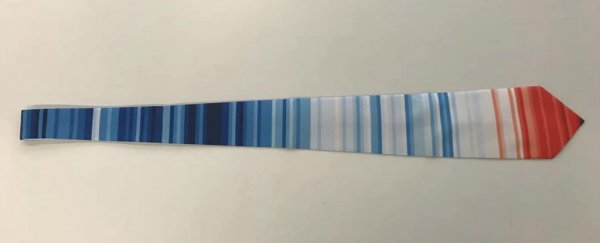On the first day of summer, midway through another historically hot year for the planet, meteorologists worldwide are wearing global warming-themed ties to raise awareness about climate change.
The ties are striped, color-coded from blue to red, to show how the planet has warmed since the late 1800s. Blue stripes represent cool years, and red stripes portray the warm years. The progression from blue to red is clear, unambiguously displaying the long-term warm signal on Earth.
While male meteorologists don ties, women are sporting pins and necklaces. Some meteorologists are displaying coffee mugs with the pattern. Cuff links and earrings are available, too.
You may see this a lot on your feed today. This "warming stripes" design was created @ed_hawkins. It shows the average global temperature from 1850 to 2017. The earth IS getting hotter #MetsUnite @WeatherProf pic.twitter.com/SsH1Pk8bo9
— Lauren Olesky (@LoleskyWX) June 21, 2018
The pattern of stripes was developed by Ed Hawkins, a climate scientist at the University of Reading in Britain. "This visualization removes all the distractions of standard graphs and allows the viewer to just see the long-term trends and variations in temperature without needing to interpret anything else," he told the Capital Weather Gang.
Jeff Berardelli, broadcast meteorologist for the CBS affiliate in Palm Beach, Fla., was inspired by the pattern.
"It struck me as an opportunity to communicate climate change in the simplest way possible," he said. He then organized the global effort to bring it inside the living rooms of television viewers.
As the pattern emblazoned on the ties shows, the world has witnessed the four warmest years on record over the past four years, and 17 of the 18 warmest years since 2001.
"In the past few years, it seems the impacts of climate change have accelerated," Berardelli said.
"And most climate scientists agree we have literally no time to spare to turn the ship around. When we look back, we will view 2015 to 2017 as the turning point years; the years when climate change 'got real.'"
Today is #SummerSolstice. If you see your weather presenter wearing an item of clothing like this tie, it's because he or she is visualising global temperature change >> https://t.co/JI7I9dK9J7 @CLIMATEwBORDERS #MetsUnite #ClimateChange pic.twitter.com/aUkcG2ClLF
— UN Climate Change (@UNFCCC) June 21, 2018
Berardelli used his social network and the help of Climate Central, a nonprofit climate-change communication firm that conducts outreach to meteorologists, to publicize the tie-wearing initiative. On social media, meteorologists are using the hashtag #MetsUnite to draw attention to it.
International participants include meteorologists in Canada, Belgium, Italy, United Kingdom, Germany and South Africa.
The dozens of meteorologists enthusiastically supporting this effort is symbolic of a sea change in their views about climate change.
Less than a decade ago, many broadcast meteorologists viewed climate change skeptically. In 2010, a study led by George Mason University found that about half of the weathercasters surveyed thought global warming was happening, and fewer than a third thought it was caused mostly by human activities.
But a study published late in 2017, also led by George Mason, concluded that the view of broadcast meteorologists had "rapidly" evolved.
"Newer results show that approximately 80 percent of weathercasters are convinced of human-caused climate change," the study concluded.
Berardelli wants his colleagues to not only accept the science of climate change but also to proactively communicate about it. "It occurs to me that TV meteorologists are experts in two things: the atmosphere and communication," he said.
"The question is: Why are we not leading the charge on climate change communication?"
He continued: "It is time broadcast meteorologists . . . take ownership of this conversation; not to push an agenda but to deliver honest, unbiased science information. There is so much misinformation out there. People need to hear the message from the horse's mouth. As long as we are straightforward and balanced, our audiences will gravitate towards their trusted, local credible source."
"I hope this effort is the kick-start needed to give our colleagues the confidence and motivation to lead on this vital issue."
Here is the Climate Changd Tie that #MetsUnite will be wearing. A great idea by @WeatherProf JeffBeradelli. The colorful tie shows the temperatures year by year of the warming earth pic.twitter.com/UWSwM6KYVl
— Gary Lezak (@glezak) June 21, 2018
#FIMC18 #CLIMATEwithoutBORDERS warming stripes #ClimateChange read all about it. RSA is in pic.twitter.com/6lmwTLCYcI
— Azwi Tuwani (@atuwani) June 21, 2018
My Contribution to #MetsUnite - for public awareness about the #climatecrisis #ActOnClimate #ClimateChange #Klimakrise #Klimaschutz pic.twitter.com/gdq1vJ2AZB
— Özden Terli (@TerliWetter) June 20, 2018
Welcome #summer! #summersolstice #metsunite #climatechange #wxtwitter pic.twitter.com/DyRb8MFJhe
— Cheryl Nelson (@CherylNelsonTV) June 21, 2018
Happy #summer! Hot summer days increasing in SpringMO since 1970 & we’re not alone. My necklace shows global temp trend from 1850, mix of blues turns red hot in recent decades. Thanks @ed_hawkins for the visual & @WeatherProf for nerdiest necklace ever! #MetsUnite #ClimateMatters pic.twitter.com/aff0SJV7jY
— Elisa Raffa (@Elisa_Raffa) June 21, 2018
#MetsUnite on this first day of summer to recognize that climate change is real. It’s not about politics, it’s about science. Each stripe on this coffee mug shows global temperatures since 1850. (cc: @WeatherProf) pic.twitter.com/BrNZH0cqsc
— KXAN Weather (@KXAN_Weather) June 21, 2018
What's a great way to show off a visual of our warming planet? Through a tie! Great visualization from @ed_hawkins #MetsUnite @ClimateCentral pic.twitter.com/DOsY3wpD4B
— Matt Daniel (@mattdanielwx) June 21, 2018
2018 © The Washington Post
This article was originally published by The Washington Post.
